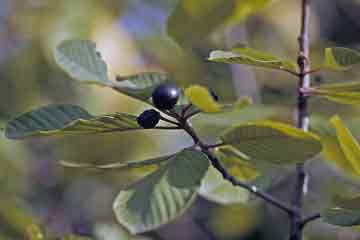Home | Next |
Previous | Index |
Purchase book
Idaho Mountain Wildflowers
Buckthorn Family, Rhamnaceae
The buckthorn family is made up worldwide of 58 genera and 875 species.
Most are tropical shrubs or small trees, although it is represented in Idaho
by plants belonging to two genera, Rhamnus and Frangula. All
of the Rhamnaceae have bark that acts as a potent purgative. Other than the
occasional use of our plants as ornamental shrubs, the purgative value of
Frangula purshiana bark (cascara, described below) makes it the only
American member of the family to have commercial value. Elsewhere the bark
and berries of various buckthorns have supplied dyes used in painting and
for textiles. The word rhamnus from which the family name was derived
is an ancient term used for a now unknown species of thorny shrub or
tree.
 |
Tobacco brush, Ceanothus
velutinus Douglas ex Hook.
(right) is common in our mountains. Other common names
include “mountain-balm,” “sticky laurel,”
“buckbrush,” “greasewood,” and just plain
“ceanothus.” Recognize it as a shrub with foamy clusters of small
flowers and signature leathery, oval, three-veined leaves. The flowers have
a odor that fills the air when many are blooming, vaguely reminiscent of
the smell of tobacco—whence its common name. The plant grows in most
of our western mountain states to subalpine elevations. The closely related
Ceanothus sanguineus Pursh (redstem ceanothus, or Oregon teatree,
not shown) is important in forest reclamation, for the plants spring up on
burned ground where its seeds have remained dormant for years, until activated
by the heat of a wildfire. |
 |
|
Cascara, Frangula purshiana
(DC.) Cooper (left, right) is a small tree with strongly
ribbed deep green leaves, small white flowers and sparse blue fruit
(berries). It is attractive, and that may be why Meriwether Lewis gathered
it near today’s Kamiah, Idaho, on May 29, 1806. Lewis made no mention
of the bark’s purgative value—apparently the Nez Perce were unaware
of this. Native Americans in California knew about cascara, however,
and told Spanish priests about its laxative effect—explaining why
the bark is known medically as cascara sagrada (Spanish for “sacred
bark”). The trees were scarce for a while in Idaho because many were
harvested for the bark. They are now grown commercially, and once again are
found in fair numbers along the Clearwater River. Frederick Pursh named the
plant but the name he gave it was already in use. When reclassified, his
name was used to honor his role in classifying Lewis and Clark plants. Until
recently, cascara was classified as a species of Rhamnus and is so
listed in many guide books. The name Frangula was derived from the
Latin frangere meaning “to break” for the brittle twigs
of some species. |
|
 |
Home | Next |
Previous | Index |
Purchase book


